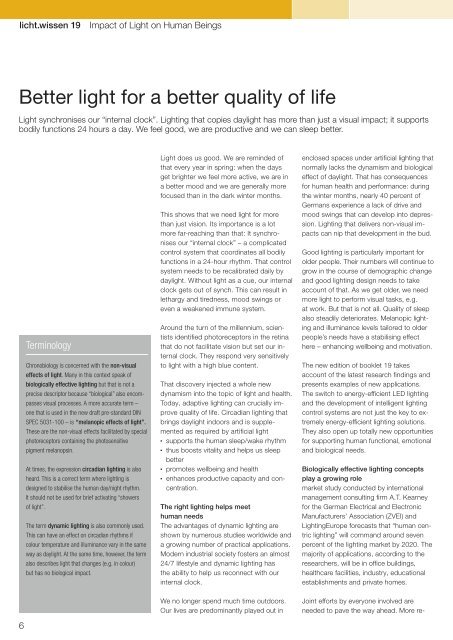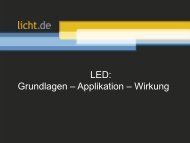licht.wissen 19 No. "Impact of Light on Human Beings"
Light synchronises our “internal clock”. Lighting that copies daylight has more than just a visual impact; it supports bodily functions 24 hours a day. Booklet 19 is intended for all those who want to delve into the topic of Impact of Light on Human Beings. The 56 pages helps to get an overview of what melanopic light can effect. Free Download at www.licht.de/en
Light synchronises our “internal clock”. Lighting that copies daylight has more than just a visual impact; it supports bodily functions 24 hours a day. Booklet 19 is intended for all those who want to delve into the topic of Impact of Light on Human Beings. The 56 pages helps to get an overview of what melanopic light can effect. Free Download at www.licht.de/en
Create successful ePaper yourself
Turn your PDF publications into a flip-book with our unique Google optimized e-Paper software.
<str<strong>on</strong>g>licht</str<strong>on</strong>g>.<str<strong>on</strong>g>wissen</str<strong>on</strong>g> <str<strong>on</strong>g>19</str<strong>on</strong>g><br />
<str<strong>on</strong>g>Impact</str<strong>on</strong>g> <str<strong>on</strong>g>of</str<strong>on</strong>g> <str<strong>on</strong>g>Light</str<strong>on</strong>g> <strong>on</strong> <strong>Human</strong> Beings<br />
Better light for a better quality <str<strong>on</strong>g>of</str<strong>on</strong>g> life<br />
<str<strong>on</strong>g>Light</str<strong>on</strong>g> synchr<strong>on</strong>ises our “internal clock”. <str<strong>on</strong>g>Light</str<strong>on</strong>g>ing that copies daylight has more than just a visual impact; it supports<br />
bodily functi<strong>on</strong>s 24 hours a day. We feel good, we are productive and we can sleep better.<br />
Terminology<br />
Chr<strong>on</strong>obiology is c<strong>on</strong>cerned with the n<strong>on</strong>-visual<br />
effects <str<strong>on</strong>g>of</str<strong>on</strong>g> light. Many in this c<strong>on</strong>text speak <str<strong>on</strong>g>of</str<strong>on</strong>g><br />
biologically effective lighting but that is not a<br />
precise descriptor because “biological” also encompasses<br />
visual processes. A more accurate term –<br />
<strong>on</strong>e that is used in the new draft pre-standard DIN<br />
SPEC 5031-100 – is “melanopic effects <str<strong>on</strong>g>of</str<strong>on</strong>g> light”.<br />
These are the n<strong>on</strong>-visual effects facilitated by special<br />
photoreceptors c<strong>on</strong>taining the photosensitive<br />
pigment melanopsin.<br />
At times, the expressi<strong>on</strong> circadian lighting is also<br />
heard. This is a correct term where lighting is<br />
designed to stabilise the human day/night rhythm.<br />
It should not be used for brief activating “showers<br />
<str<strong>on</strong>g>of</str<strong>on</strong>g> light”.<br />
The term dynamic lighting is also comm<strong>on</strong>ly used.<br />
This can have an effect <strong>on</strong> circadian rhythms if<br />
colour temperature and illuminance vary in the same<br />
way as daylight. At the same time, however, the term<br />
also describes light that changes (e.g. in colour)<br />
but has no biological impact.<br />
<str<strong>on</strong>g>Light</str<strong>on</strong>g> does us good. We are reminded <str<strong>on</strong>g>of</str<strong>on</strong>g><br />
that every year in spring: when the days<br />
get brighter we feel more active, we are in<br />
a better mood and we are generally more<br />
focused than in the dark winter m<strong>on</strong>ths.<br />
This shows that we need light for more<br />
than just visi<strong>on</strong>. Its importance is a lot<br />
more far-reaching than that: It synchr<strong>on</strong>ises<br />
our “internal clock” – a complicated<br />
c<strong>on</strong>trol system that coordinates all bodily<br />
functi<strong>on</strong>s in a 24-hour rhythm. That c<strong>on</strong>trol<br />
system needs to be recalibrated daily by<br />
daylight. Without light as a cue, our internal<br />
clock gets out <str<strong>on</strong>g>of</str<strong>on</strong>g> synch. This can result in<br />
lethargy and tiredness, mood swings or<br />
even a weakened immune system.<br />
Around the turn <str<strong>on</strong>g>of</str<strong>on</strong>g> the millennium, scientists<br />
identified photoreceptors in the retina<br />
that do not facilitate visi<strong>on</strong> but set our internal<br />
clock. They resp<strong>on</strong>d very sensitively<br />
to light with a high blue c<strong>on</strong>tent.<br />
That discovery injected a whole new<br />
dynamism into the topic <str<strong>on</strong>g>of</str<strong>on</strong>g> light and health.<br />
Today, adaptive lighting can crucially improve<br />
quality <str<strong>on</strong>g>of</str<strong>on</strong>g> life. Circadian lighting that<br />
brings daylight indoors and is supplemented<br />
as required by artificial light<br />
<br />
supports the human sleep/wake rhythm<br />
<br />
thus boosts vitality and helps us sleep<br />
better<br />
<br />
promotes wellbeing and health<br />
<br />
enhances productive capacity and c<strong>on</strong>centrati<strong>on</strong>.<br />
The right lighting helps meet<br />
human needs<br />
The advantages <str<strong>on</strong>g>of</str<strong>on</strong>g> dynamic lighting are<br />
shown by numerous studies worldwide and<br />
a growing number <str<strong>on</strong>g>of</str<strong>on</strong>g> practical applicati<strong>on</strong>s.<br />
Modern industrial society fosters an almost<br />
24/7 lifestyle and dynamic lighting has<br />
the ability to help us rec<strong>on</strong>nect with our<br />
internal clock.<br />
enclosed spaces under artificial lighting that<br />
normally lacks the dynamism and biological<br />
effect <str<strong>on</strong>g>of</str<strong>on</strong>g> daylight. That has c<strong>on</strong>sequences<br />
for human health and performance: during<br />
the winter m<strong>on</strong>ths, nearly 40 percent <str<strong>on</strong>g>of</str<strong>on</strong>g><br />
Germans experience a lack <str<strong>on</strong>g>of</str<strong>on</strong>g> drive and<br />
mood swings that can develop into depressi<strong>on</strong>.<br />
<str<strong>on</strong>g>Light</str<strong>on</strong>g>ing that delivers n<strong>on</strong>-visual impacts<br />
can nip that development in the bud.<br />
Good lighting is particularly important for<br />
older people. Their numbers will c<strong>on</strong>tinue to<br />
grow in the course <str<strong>on</strong>g>of</str<strong>on</strong>g> demographic change<br />
and good lighting design needs to take<br />
account <str<strong>on</strong>g>of</str<strong>on</strong>g> that. As we get older, we need<br />
more light to perform visual tasks, e.g.<br />
at work. But that is not all. Quality <str<strong>on</strong>g>of</str<strong>on</strong>g> sleep<br />
also steadily deteriorates. Melanopic lighting<br />
and illuminance levels tailored to older<br />
people’s needs have a stabilising effect<br />
here – enhancing wellbeing and motivati<strong>on</strong>.<br />
The new editi<strong>on</strong> <str<strong>on</strong>g>of</str<strong>on</strong>g> booklet <str<strong>on</strong>g>19</str<strong>on</strong>g> takes<br />
account <str<strong>on</strong>g>of</str<strong>on</strong>g> the latest research findings and<br />
presents examples <str<strong>on</strong>g>of</str<strong>on</strong>g> new applicati<strong>on</strong>s.<br />
The switch to energy-efficient LED lighting<br />
and the development <str<strong>on</strong>g>of</str<strong>on</strong>g> intelligent lighting<br />
c<strong>on</strong>trol systems are not just the key to extremely<br />
energy-efficient lighting soluti<strong>on</strong>s.<br />
They also open up totally new opportunities<br />
for supporting human functi<strong>on</strong>al, emoti<strong>on</strong>al<br />
and biological needs.<br />
Biologically effective lighting c<strong>on</strong>cepts<br />
play a growing role<br />
market study c<strong>on</strong>ducted by internati<strong>on</strong>al<br />
management c<strong>on</strong>sulting firm A.T. Kearney<br />
for the German Electrical and Electr<strong>on</strong>ic<br />
Manufacturers’ Associati<strong>on</strong> (ZVEI) and<br />
<str<strong>on</strong>g>Light</str<strong>on</strong>g>ingEurope forecasts that “human centric<br />
lighting” will command around seven<br />
percent <str<strong>on</strong>g>of</str<strong>on</strong>g> the lighting market by 2020. The<br />
majority <str<strong>on</strong>g>of</str<strong>on</strong>g> applicati<strong>on</strong>s, according to the<br />
researchers, will be in <str<strong>on</strong>g>of</str<strong>on</strong>g>fice buildings,<br />
healthcare facilities, industry, educati<strong>on</strong>al<br />
establishments and private homes.<br />
6<br />
We no l<strong>on</strong>ger spend much time outdoors.<br />
Our lives are predominantly played out in<br />
Joint efforts by every<strong>on</strong>e involved are<br />
needed to pave the way ahead. More re-

















